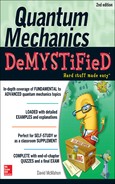
Final Exam
Select the best answer for the following multiple-choice questions. Answers are located at the back of the text.
1. The wavefunction for a particle trapped in an infinite square well defined for 0 ≤ x ≤ a can be written as
A. 
B. 
C. 
D. 
2. A wavefunction is defined by

The best description of the Fourier transform of this function is that it includes
A. a Hankel function
B. a sum of cos functions
C. the Dirac delta function
3. The time-energy uncertainty relation can be written as
A. 
B. 
C. 
D. 
4. In one-dimension, the full Schrödinger equation is
A. 
B. 
C. 
D. 
5. The expectation value of an operator A can be written as
A. 
B. 
C. 
D. Both a and b are correct.
6. A wavefunction is expanded in a set of basis states as  . The coefficients of the expansion
. The coefficients of the expansion
A. Must satisfy 
B. Must satisfy 
C. Must be real numbers
D. There are no restrictions.
7. If the wavefunction for a two-particle quantum state satisfies  , it is best described as
, it is best described as
A. A photon
B. A fermion
C. A boson
8. A wavefunction is written in terms of an orthonormal basis as
The probability that the system is found in the state  is
is
A. 1/3
B. 0.17
C. 0.13
D. 5/6
9. A wavefunction is expanded in terms of an orthonormal basis in the following way:
Then A must be
A. 
B. 1/5
C. 2/5
D. 1/2
E. There is not enough information given.
10. The coefficients of expansion for some basis can be written as
A. 

B. 
C. 
D. 
11. The Hermitian conjugate of an operator A is
A. 
B. 
C. 
D. 
12. The base kets of position space satisfy
A. 
B. 
C. 
D. 
13. By using time-independent perturbation theory, the second-order energies of a quantum system can be calculated using
A. 
B. 

C. 

D. 

14. If we denote the position space operator by  , which of the following best describes its action on the base kets?
, which of the following best describes its action on the base kets?
A. 
B. 
C. 
D. 
15. A unitary operator satisfies
A. UU† = −UU†U − = I
B. UU† = 0
C. UU† = U†U = I
D. UU† = U†U = −I
16. The energy levels of the one-dimensional harmonic oscillator are
A. Equally spaced
B. 2-fold degenerate
C. 3-fold degenerate
D. not degenerate
E. a and d
17. In the coordinate representation, the eigenstates of the one-dimensional harmonic oscillator can be written in terms of
A. Hermite polynomials
B. Hankel functions
C. Legendre polynomials
D. Bessel functions of the second kind
18. The energy eigenvalues of the one-dimensional harmonic oscillator are
A. 
B. 
C. 
D. 
19. Consider the one-dimensional harmonic oscillator. The commutator [H, a†] is equal to
A. a†
B.  ωa
ωa
C. − ωa†
ωa†
D.  ωa†
ωa†
20. A particle is in an angular momentum eigenstate  . The expectation value
. The expectation value  is equal to
is equal to
A.  l(l + 1)
l(l + 1)
B. 
C. 0
D.  2l2(l + 1)
2l2(l + 1)
21. A spin-1 particle is in the state

If spin is measured in the z direction, the probability that m = +1 is found is
A. 3/7
B. 1/2
C. 4/7
D. 1/7
22. Consider the hydrogen atom. The angular probability distribution is given by
A. 
B. 
C. 
D. 
23. Which of the following is the best statement about bosons and fermions?
A. All particles with integer spin are fermions; those with half-integer spin are bosons.
B. All particles with integer spin are bosons; those with half-integer spin are fermions.
C. Particles with zero spin are fermions; all others are bosons.
D. Particles with zero spin are bosons; all others are fermions.
24. Consider two noninteracting particles in an infinite square well. If the particles are distinguishable, the composite wavefunction is
A. 
B. 
C. 
D. 
25. In nondegenerate perturbation theory, if the Hamiltonian can be written as H = H0 + λH′, the first-order correction to the energy can be written as
A. 
B. 
C. 
26. The magnetic dipole of the electron is proportional to its
A. Angular momentum
B. Spin
C. Charge
27. Total angular momentum J can be written as
A. 
B. 
C. 
D. 
28. We know that the energy levels of an atom are shifted when it is placed in a uniform external magnetic field. This is known as
A. The Stark effect
B. The Zeeman effect
C. The magnetic dipole effect
D. Hyperfine splitting
29. The Einstein A coefficient gives the
A. Probability for absorption of a photon
B. Strength of the magnetic dipole moment
C. Spontaneous emission rate
D. Stimulated emission rate
30. The lifetime of an excited atomic state is
A. 
B. 
C. 
D. 
..................Content has been hidden....................
You can't read the all page of ebook, please click here login for view all page.
